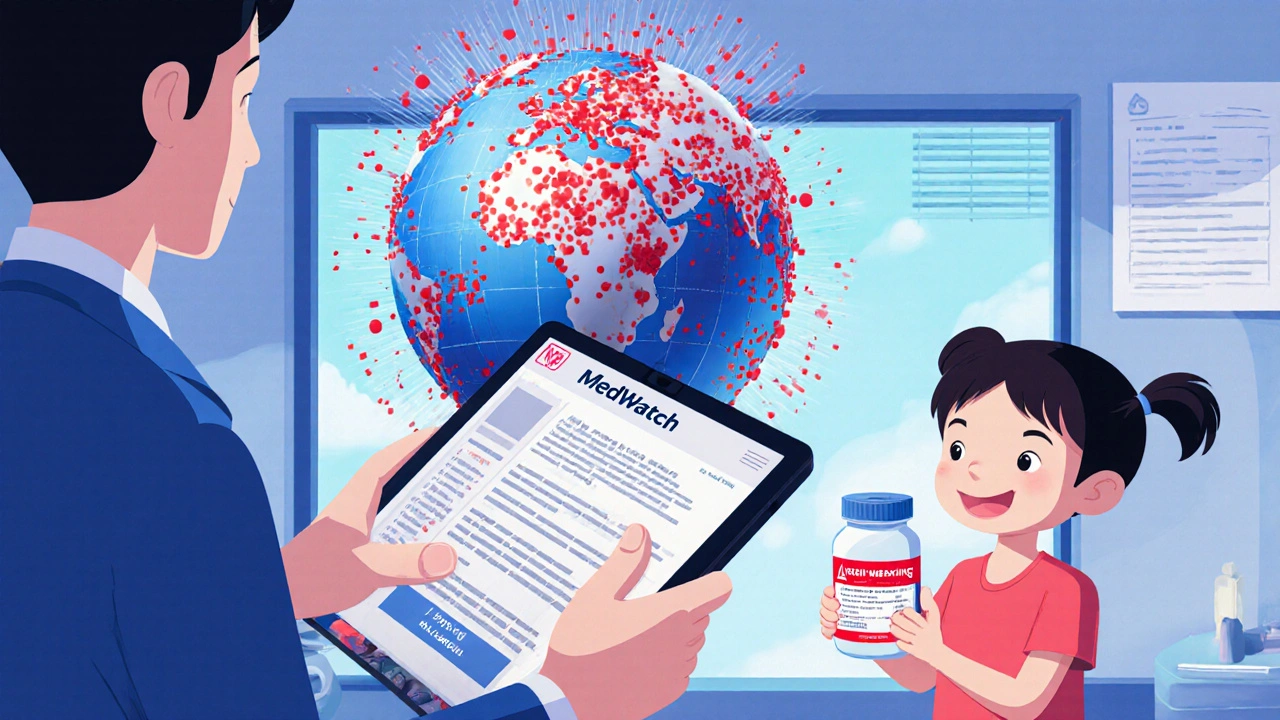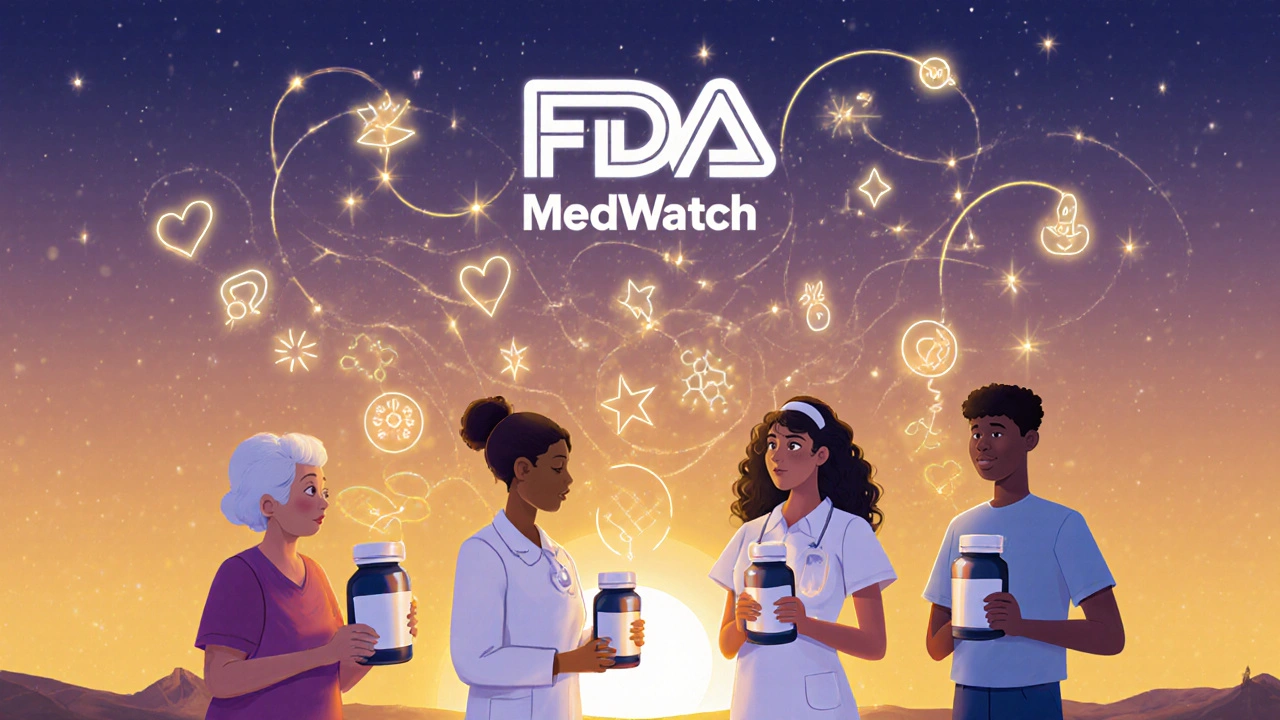Every year, over 1.3 million adverse drug reactions are reported to the FDA through MedWatch. But here’s the truth: experts estimate only about 6% of serious reactions ever make it into the system. That means for every 17 dangerous side effects that happen, 16 go unreported. If you’ve ever had a bad reaction to a medication-whether it was a prescription, an over-the-counter pill, or even a supplement-you have a role to play in keeping others safe. Reporting isn’t just paperwork. It’s how the FDA finds hidden dangers before more people get hurt.
What Is MedWatch and Why Does It Matter?
MedWatch is the U.S. Food and Drug Administration’s official system for collecting reports about harmful side effects from medicines, medical devices, dietary supplements, and even some foods and cosmetics. It started in 1993, but its purpose hasn’t changed: catch safety problems that didn’t show up during clinical trials. Those trials involve thousands of people. Real-world use involves millions. Someone might have a rare allergy. A drug might interact badly with a common vitamin. A device might fail under normal use. These aren’t accidents. They’re signals.The FDA doesn’t have a crystal ball. They rely on people like you-doctors, nurses, pharmacists, patients, and caregivers-to tell them when something goes wrong. Without these reports, a drug that causes liver damage in 1 out of 50,000 people might stay on the market for years. That’s how the FDA found the link between Vioxx and heart attacks. That’s how they updated warnings for certain diabetes drugs after reports of pancreatitis. MedWatch is the early warning system.
Who Can and Should Report?
Anyone can report. You don’t need to be a doctor. If you took a medication and felt worse-really worse-you can report it. Patients, family members, and caregivers are encouraged to use the consumer form. Healthcare professionals are expected to report, but many don’t. A 2023 survey found that 68% of U.S. physicians rarely or never file a MedWatch report. Why? Time. Uncertainty. They don’t know if it’s “serious enough.”The FDA says: if you’re unsure, report it anyway. You’re not deciding whether the drug caused it. You’re telling them something happened. The FDA’s scientists will figure out if it’s connected. You’re the eyes on the ground.
What Counts as a Reportable Event?
Not every minor side effect needs reporting. The FDA defines a “serious” adverse event as one that:- Results in death
- Requires hospitalization
- Causes persistent or significant disability
- Leads to a congenital anomaly or birth defect
- Is life-threatening
- Requires medical or surgical intervention to prevent one of the above
Examples: A 72-year-old on blood pressure meds develops sudden kidney failure. A teenager takes ibuprofen and has a severe allergic reaction with swelling and trouble breathing. A diabetic patient starts a new insulin and ends up in the ER with dangerously low blood sugar. These aren’t rare. They happen every day. And they’re reportable.
Even if the reaction isn’t listed on the drug’s label, report it. Labels lag behind real-world data. The FDA adds new warnings all the time because someone filed a report.
How to File a Report: Step by Step
There are three forms, but you only need to know two:- For patients and caregivers: Use Form 3500B - This is the consumer version. It’s written in plain language. You can fill it out online or print and mail it. It takes about 15-20 minutes.
- For healthcare professionals: Use Form 3500 - This one has more medical detail fields. If you’re a nurse, doctor, or pharmacist, use this. It’s also available online.
- Manufacturers and hospitals - They use Form 3500A and must report by law. You don’t need to worry about this one.
Here’s what you’ll need to have ready:
- Full name of the drug (brand and generic)
- Dosage and how often it was taken
- Date you started and stopped the drug
- When the reaction started
- What happened (describe symptoms clearly-don’t say “felt bad,” say “swelling in throat, difficulty swallowing, rash spreading across chest”)
- Outcome: Did you recover? Are you still in the hospital? Did you need treatment?
- Any other medications or supplements you were taking
- Your age and gender (optional but helpful)
Don’t worry about proving the drug caused it. The FDA knows you can’t. They’re looking for patterns. If 20 people report the same reaction after taking the same drug, that’s a red flag.

Where to Submit
The easiest way is online:- Go to www.fda.gov/medwatch
- Click “Report a Problem”
- Choose the right form (3500 for professionals, 3500B for patients)
- Fill it out and submit
You can also:
- Call 1-800-FDA-1088 (24/7)
- Mail a completed form to: MedWatch, FDA, 5600 Fishers Lane, Rockville, MD 20852
Online is fastest. Phone is good if you’re not comfortable typing. Mail works if you’re older or don’t have internet.
What Happens After You Submit?
You won’t get a thank-you note. You won’t get a call. That’s frustrating, but it’s normal. The FDA receives over 1,300 reports a day. They’re not going to follow up with each person. But here’s what does happen:- Your report goes into FAERS-the FDA’s Adverse Event Reporting System
- Analysts look for clusters: same drug, same symptom, multiple reports
- If a pattern emerges, the FDA may issue a safety alert
- They might require the manufacturer to update the drug label
- In rare cases, they may require a boxed warning, restrict use, or even pull the drug
Some reports lead to changes you’ve probably seen: “May cause liver injury” on a painkiller label. “Avoid if you have kidney disease” on an antibiotic. Those warnings didn’t appear out of nowhere. Someone reported it.
Why So Few People Report
A 2022 survey by the American Society of Health-System Pharmacists found that 87% of healthcare professionals never received any feedback on their MedWatch reports. That makes people feel like their effort doesn’t matter. It’s discouraging. But here’s the thing: the system doesn’t work if only manufacturers report. If doctors stop reporting, the FDA loses half the picture. If patients stop, they lose the rest.Time is a big barrier. The average report takes 12-15 minutes. For a busy clinician, that’s a lot. The FDA is trying to fix that. Their “MedWatch Plus” initiative, launching by 2025, will integrate reporting directly into electronic health records. That means when a doctor documents a reaction in the patient’s chart, the system will auto-generate a MedWatch form. No extra steps. That’s the future.

What’s Changing in 2025?
The FDA is upgrading. They’re adding AI to sort through the 1.3 million reports faster. They’re expanding coverage to include more dietary supplements. They’re working with pharmacies to make reporting easier at the point of sale. And they’re pushing for mandatory reporting from more manufacturers.But none of this matters if people don’t report. The system is only as strong as the reports it gets. Every form you fill out adds to the evidence. Every time you say, “This didn’t seem right,” you help prevent someone else from getting hurt.
Real Example: What One Report Can Do
In 2020, a nurse in Ohio reported that a patient on a common antibiotic developed sudden, severe muscle weakness. The reaction wasn’t listed in the drug’s literature. Three other nurses in different states filed similar reports over the next six months. The FDA pulled the data. They found 17 cases total. Within a year, the drug label was updated to warn about this rare but dangerous side effect. That change saved lives. That nurse didn’t know it at the time, but she was part of a safety net.Final Thought: You’re Not Just a Patient. You’re a Sentinel.
MedWatch isn’t glamorous. It’s not a breakthrough drug or a new device. It’s a quiet, behind-the-scenes system that works because ordinary people care enough to speak up. You don’t need to be an expert. You just need to notice. You just need to report.Next time you or someone you know has a strange reaction to a medication-don’t shrug it off. Don’t assume it’s “just a side effect.” Take 15 minutes. Go to MedWatch. Submit the form. Someone, somewhere, will benefit from your report.
Do I need to prove the drug caused the reaction to report it?
No. You don’t need to prove causation. The FDA accepts reports of suspected adverse events-even if you’re not sure the drug caused it. Their job is to look for patterns across thousands of reports. Your report is one piece of evidence. You’re not deciding if it’s linked-you’re flagging it for review.
Can I report a reaction to a supplement or OTC medicine?
Yes. MedWatch covers prescription drugs, over-the-counter medicines, dietary supplements, medical devices, cosmetics, and even certain foods if they cause a serious allergic reaction. If it’s sold legally in the U.S. and you had a serious reaction, you can report it.
How long does it take to fill out the form?
For patients using Form 3500B, it usually takes 15-20 minutes. Healthcare professionals using Form 3500 may take slightly longer, depending on how much detail they include. The FDA says the process is straightforward, and the website has guided steps to help you along.
Will I get a response after submitting my report?
Most people don’t receive a personal reply. The FDA processes over 1,300 reports daily and doesn’t have the resources to respond individually. But your report is logged into the national database and analyzed for trends. If your report helps identify a new safety issue, the FDA may issue a public alert-but you won’t be notified directly.
Is MedWatch only for U.S. residents?
Yes. MedWatch is for adverse events involving products sold or used in the United States. If you’re outside the U.S. and had a reaction to a U.S.-approved drug, you can still report it. If you’re reporting a reaction to a product sold only in another country, contact your own nation’s drug safety agency.
What if I report and nothing happens? Was it worth it?
Yes. Most safety changes come from multiple reports over months or years. One report might not trigger action, but 10 or 20 can. The FDA doesn’t act on single cases-it looks for clusters. Your report adds to the pile. If you don’t report, that pile stays smaller. And someone else might get hurt because no one spoke up.

